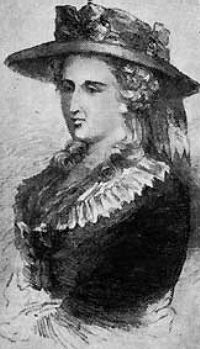<Back to Index>
- Physician Carlos Justiniano Ribeiro Chagas, 1879
- Novelist Ann Radcliffe, 1764
- Chairman of the Council of Ministers of the German Democratic Republic Willi Stoph, 1914
PAGE SPONSOR

Ann Radcliffe (9 July 1764 – 7 February 1823) was an English author, and considered the pioneer of the gothic novel (although she was not the first to publish a book of this style). Her style is romantic in its vivid descriptions of landscapes, and long travel scenes, yet the Gothic element is obvious through her use of the supernatural. It was her triumph of reason, and explanation of the seemingly inexplicable supernatural that helped the Gothic novel to become culturally acceptable.
Very little is known of Ann Radcliffe's life. The Edinburgh Review, published in 1823 (the year of her death) said of her: 'She never appeared in public, nor mingled in private society, but kept herself apart, like the sweet bird that sings its solitary notes, shrouded and unseen‘ (Facer). Christina Rossetti attempted to write a biography about her life, but abandoned it for lack of information.
As far as is known, there are no images available of Ann Radcliffe. The one on this page is popularly circulated on the internet, but is a stock image, and not a resemblance of Radcliffe. According to Ruth Facer: “Physically, she was said to be 'exquisitely proportioned' – quite short, complexion beautiful 'as was her whole countenance, especially her eyes, eyebrows and mouth‘”.
Radcliffe was born as Ann Ward in Holborn, London on
July 9th, 1764. Her father was William Ward, a haberdasher (who later
moved to Bath to managed a China shop); her mother was Ann Oates. In
1787, she married Oxford graduate and journalist William Radcliffe,
part-owner and editor of the English Chronicle. He often came home
late, and to occupy her time she began to write and read her work to
him when he returned home. They had a childless, but seemingly happy
marriage. Ann called him her 'nearest relative and friend'.
Later they traveled together, along with their dog, Chance, using
profits from her novels. When Ann died on February 7th, 1823, there
were some reports that she was insane. However, her husband adamantly
claimed that she had died of an asthma attack. Ann's
fiction is characterized by seemingly supernatural events being
explained through reason. Throughout her work traditional morals are
asserted, women’s rights are advocated for, and reason prevails. Ann published 6 novels in all. These are (listed alphabetically): The Castles of Athlin and Dunbayne, Gaston de Blondeville, The Italian, The Mysteries of Udolpho, The Romance of the Forest and A Sicilian Romance. She also published a book of poetry, but her talent for prose far exceeded her poetic ability. Radcliffe
is considered to be the founder of Gothic Literature. While there were
others that preceded her, Radcliffe was the one that legitimized Gothic
literature. Sir Walter Scott called her the 'founder of a class or
school‘. Radcliffe's novel, The Mysteries of Udolpho, was parodied by Jane Austen in Northanger Abbey. Radcliffe did not like where Gothic literature was headed, and her final novel, The Italian, was written in response to Matthew Gregory Lewis's The Monk. It is assumed that this frustration is what caused Radcliffe to cease writing. Ann
Radcliffe had a profound influence on many later authors. These
include: The Marquis de Sade (1740 - 1814), Edgar Allan Poe (1809 - 1849)
and Sir Walter Scott (1771 - 1832). Sir Walter Scott also interspersed
his work with poems, as did Radcliffe. Indeed, "Scott himself said that
her prose was poetry and her poetry was prose. She was, indeed, a prose
poet, in both the best and the worst senses of the phrase. The romantic
landscape, the background, is the best thing in all her books; the
characters are two dimensional, the plots far fetched and improbably,
with 'elaboration of means and futility of result'" (Entry in British Authors Before 1800: A Biographical Dictionary Ed. Stanley Kunitz and Howard Haycraft. New York: H.W. Wilson, 1952. pg. 427.) Radcliffe's elaborate description of landscapes was influenced by the painters Claude Lorraine and Salvator Rosa.
She often wrote about places she had never been. Lorraine's influence
can be seen through Radcliffe's picturesque, romantic descriptions of
landscapes, as seen in volume one of The Mysteries of Udolpho. Rosa's influence can be seen through dark landscapes and elements of the Gothic. Radcliffe said of Lorraine: “In
a shaded corner, near the chimney, a most exquisite Claude, an evening
view, perhaps over the Campagna of Rome. The sight of this picture
imparted much of the luxurious repose and satisfaction, which we derive
from contemplating the finest scenes of nature. Here was the poet, as
well as the painter, touching the imagination, and making you see more
than the picture contained. You saw the real light of the sun, you
breathed the air of the country, you felt all the circumstances of a
luxurious climate on the most serene and beautiful landscape; and the
mind thus softened, you almost fancied you hear Italian music in the
air”. Paul Féval, père, used her as his protagonist in the novel La Ville Vampire. In the film Becoming Jane, she is portrayed by Helen McCrory, in a scene where she meets Jane Austen and
encourages her to embark on a writing career (there is no historical
evidence of such a meeting, though as noted Radcliffe's works had
clearly influenced Austen's). In Maria Edgeworth's book Belinda,
Lady Delacour remarks on Clarence Hervey's letters, "Here, my love, if
you like description... here is a Radcliffean tour along the picturesque
coasts of Dorset and Devonshire." A biography of Radcliffe, by Deborah Rogers, was published in 1996.